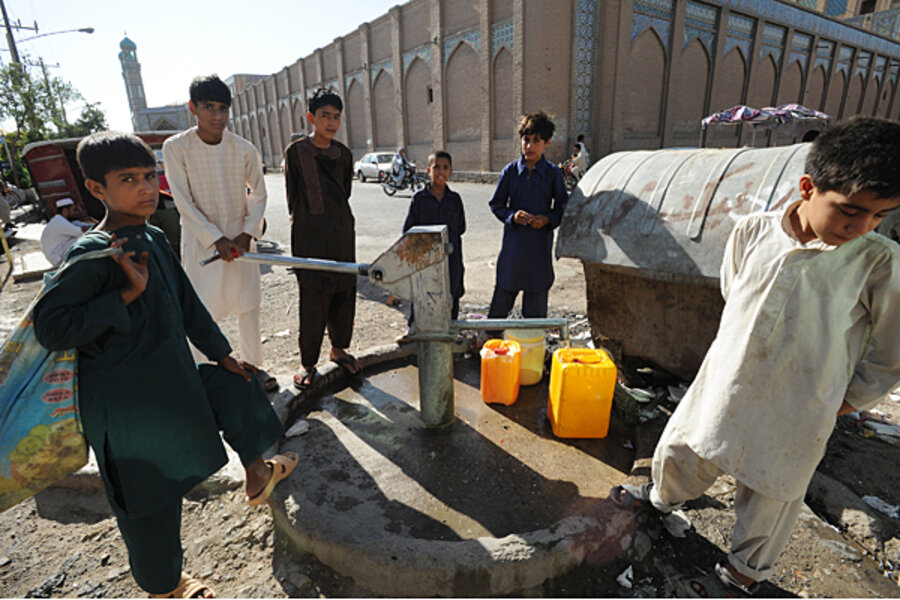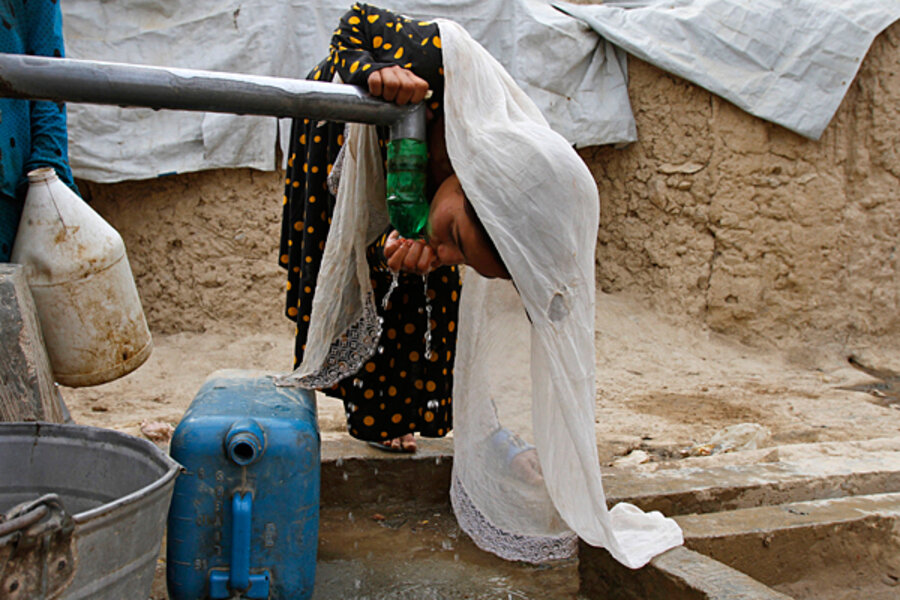Why a dam in Afghanistan might set back peace
| Herat, Afghanistan
The water that grows western Afghanistan’s fresh produce, sprinkles its town parks with shade-giving trees, and slakes the thirst of war-weary Afghans, is becoming a point of tension with nearby Iran as a large dam under construction will constrict cross-border flow.
After nearly four decades of work, the Salma Dam – a $200 million project paid for and built by India, yet delayed by Afghanistan’s turbulent history of occupations, civil war, and insurgency – is slated to be finished by the end of 2014.
Afghan officials say they have no plans to negotiate water rights with Iran, although analysts and Western sources warn that lack of agreement could worsen Afghanistan’s already prickly ties with its Iranian neighbor.
“We have many projects in Afghanistan, and every project has its enemy. But unfortunately Salma Dam has three enemies,” says Fazl Ahmad Zakeri, the Ministry of Energy and Water’s acting director for the Harirud and Murghab River Basin, in Herat. “It’s not possible [to stop work]. We will complete this dam.”
One of those enemies, says Mr. Zakeri, is Pakistan. Islamabad is “trying to stop the work” because it is being built by strategic rival India. In April, Afghan intelligence officials announced they had thwarted a Taliban plot to blow up the dam with about 2,860 pounds of explosives. The plan, they claimed, was aided by Pakistan’s intelligence agency.
The other two “enemies” of the Salma Dam are Turkmenistan and Iran because it will diminish water flow to their own parched regions and dam projects. Afghan officials have often charged Iran with being behind dam-related attacks. When an Afghan district governor who had supported the project was killed in 2010, Afghan police officials suspected Iran’s involvement.
The head of the police unit guarding the dam claimed to have evidence that Iran funded a local Taliban commander and his 200 men who had “promised Iran that he will succeed in halting work on the Salma Dam,” according to a report by the Institute for War and Peace Reporting.
Likewise, two months ago, six of the dam’s security guards were killed by a roadside bomb. Without naming Iran, the provincial security chief said that the killings had “a political motivation. This is the work of those countries who don’t want Afghanistan to develop.”
But in Herat, water official Zakeri says that “we don’t have any data to give us information that Iran is creating some problem.” Iranian officials say they support Afghan development, and deny conducting any destabilizing actions in Afghanistan, despite credible reports of past, limited assistance to anti-US insurgents, including the Taliban.
“Yes, the Iranians are asking for negotiations. Always they are asking for negotiations [because they will get] much less water,” notes Zakeri.
But negotiation may be easier said than done, with so much at stake for both sides.
What Afghanistan wants
For Afghanistan, key facts are clear: The Salma Dam will increase cultivatable land from 35,000 hectares to 80,000 hectares. It will also produce 42 MW of electricity, lowering the region’s dependence on Iran (which now provides 80 MW, cheaply) and Turkmenistan (which provides 50 MW).
“It will change much, because this project is not just for Herat,” says Zakeri. “If we can produce more fruit, we can send this to Kandahar, to other provinces. This project might change the situation in all of Afghanistan.”
For Iran, too, key facts are clear: The dam will cut the flow of its own Harirud River water by 73 percent, even though the number of Iranians dependent on that water – including the shrine city of Mashhad – is almost three times as large as the number of Afghans.
“Iran has always criticized Afghanistan for its water policies on Helmand and Harirud Rivers,” says an Iranian analyst in Tehran who has worked on the issue of Helmand, a larger river flowing into Iran farther south, and asked not to be named. “Iran and Pakistan are both accused of sabotage [and] Mashhad depends on the water of the Harirud. So Iran has a big concern that dams in Afghanistan [will] reduce the water as [they have] on Helmand.”
The 'only way forward'
A 2010 report on Afghanistan’s water resources warned that “cross-border cooperation on water is not an option; it is the only way forward” with all neighbors. Lack of bilateral or regional agreements created “a serious threat to sustainable development and security in the region,” stated the EastWest Institute report.
The report also noted that a model for cooperation already exists, for the Helmand River. Afghanistan and Iran first created a joint commission in 1950, and in 1973 agreed that Iran would receive a precise volume.
For now, however, Kabul doesn’t “see any reason” to hold water negotiations with Iran over the Selma Dam, says Shujaudin Ziaye, the deputy minister of Energy and Water in Kabul.
“We have no new negotiations in the past two years. The idea of building this dam emerged 40 years back. At that time, Iran had no request of water,” says Mr. Ziaye. “Maybe they need to talk with us, but we don’t see any need to talk with Iran, to negotiate about water. Right now, no.”
High priority
For many Afghans, water resources are a high priority. When President Hamid Karzai met an audience of ordinary Afghans in March for a televised program, there were nearly as many questions about water as about security.
“How much can the Afghan government defend its water resources?” asked one man, after listing the country’s water systems. Another asked why the government did not build more dams so Afghans “will have access to electricity and the dry deserts will be irrigated.”
Mr. Karzai replied: “We know that some of our neighboring countries do not want our dams to be built and do not want us to have our own electricity.” He also said that “we have used our waters less throughout history and the neighbors have used them more. We know this, but we want to manage it in good relations with [them].”
But a history of mutual suspicions abounds. Iran has offered some technical expertise to Afghanistan, on water and agricultural issues. Iran’s Minister of Energy Majid Namjou visited in January to cut the ribbon on two Iranian-made electric turbines given to Herat for emergency use.
“Iran, it seems, has adopted competing policies on Afghanistan – one of cooperation in certain cases and one that contributes to destabilizing in others,” stated the EastWest Institute report. “Iran perceives agricultural development – a crucial element in the Obama strategy to increase economic activity in Afghanistan – and dam rehabilitation and reconstruction as major security threats.”
In Herat, that is also how some Afghan officials see it.
“If we have sustainable agriculture, and sustainable industries in Herat and our western zone of Afghanistan; if we have security – especially in Herat – then our Salma Dam will be built, and [Iran] will face many challenges, in their agriculture and industry,” says Herat Chief of Police Rahmatullah Safai.







